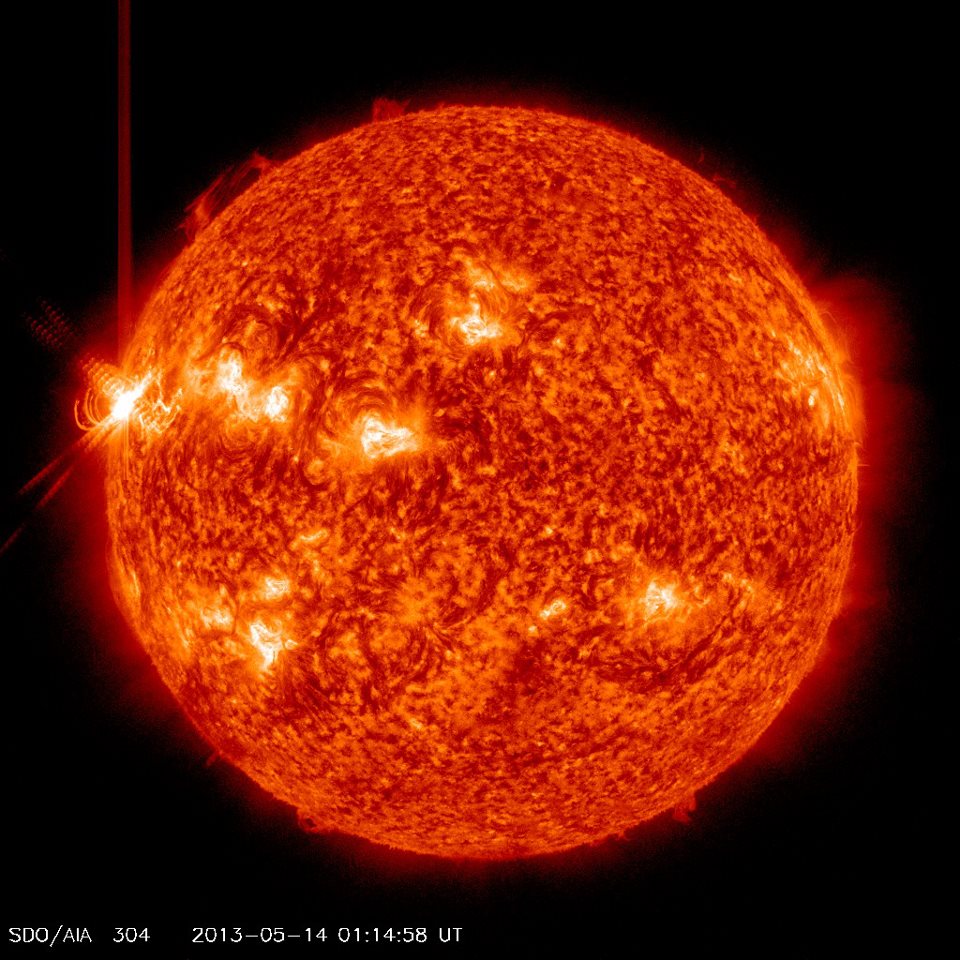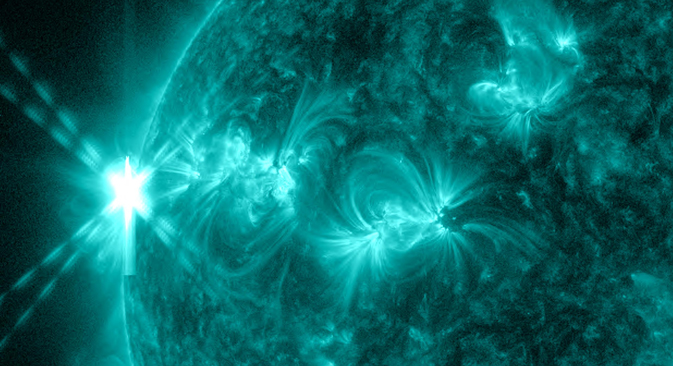Hyperactive Sun Fires Off 3 Major Solar Flares in 1 Day

The sun, it seems, is in overdrive. Late Monday night, the sun unleashed its third major solar flare in 24 hours — the biggest and most powerful solar storm of the year, so far.
This latest sun storm erupted Monday (May 13) at 9:11 p.m. EDT (0111 GMT) and registered as an X3.2 solar flare, one of the strongest types of flares the sun can release, space weather officials said. It came on the heels of two other recent X-class solar flares on Sunday night and Monday, all of which were sparked by a highly active sunspot on the sun's far left side.
Officials at the NOAA Space Weather Prediction Center in Boulder, Colo., appeared amazed at the intense activity from the crackling sunspot. [Sun Unleashes Biggest Flares of 2013 (Photos)]
"Clearly an extraordinary active region is making its way fully onto the visible disk," SWPC officials wrote in a morning update today (May 14). "Can it keep up this hectic pace?"
Two of the three recent solar flares have been associated with massive explosions, called coronal mass ejections, which flung super-hot solar material into space at millions of miles per hour. Because the sunspot firing off the flares is not yet facing Earth, the solar eruptions pose no threat to satellites and astronauts in orbit, NASA has said.
"This marks the 3rd X-class flare in 24 hours," officials with NASA's sun-watching Solar Dynamics Observatory wrote in a statement. "Just like the two before this one also happened over the eastern limb of the sun and is not Earth-directed."
The Solar Dynamics Observatory captured amazing videos of the major solar flares and eruptions.
Breaking space news, the latest updates on rocket launches, skywatching events and more!
According to astronomer Tony Phillips of Spaceweather.com, scientists have just given the active sunspot a name: AR1748. It is one of nine active numbered sunspots currently visible on the surface of the sun.
While AR1784 has been spouting off many solar flares in recent days, most of them more moderate, M-class solar flares, the events on Sunday and Monday are taking solar activity to another level.
"These are the strongest flares of the year so far, and they signal a significant increase in solar activity," Phillips wrote in a Spaceweather.com update this morning.
Scientists use a tiered space weather scale to classify solar flare events, with each level representing a tenfold increase in power over the one before. At the bottom of the scale are A and B type solar flares, which have no effect on Earth. Next are C-class solar flares and the stronger, yet still medium-strength, M-class solar flares, which can supercharge Earth's auroras and cause radio blackouts when aimed at Earth.
X-class solar flares are the most powerful types of solar storms. When aimed directly at Earth, these major solar events can pose a danger to astronauts and satellites in space, as well as interfere with radio and GPS navigation signals.
The X3.2 solar flare is the most powerful yet seen this year and the third-strongest sun storm of the current 11-year solar cycle, called Solar Cycle 24. The second strongest was an X5.4 solar flare in 2012, while the largest event was an X6.9 flare in 2011. So far, there have been 18 X-class solar flares in Solar Cycle 24.
The first X-class solar flare of 2013 (the Sunday event) registered as an X1.7 on the flare scale, with the mid-day Monday flare rating as an X2.8, NASA officials said.
Solar activity on the sun rises and falls over the course of its 11-year cycle. The sun is active phase of Solar Cycle 24 as it approaches its peak activity period, called solar maximum, which is expected to occur later this year.
Scientists have been monitoring solar flares and other space weather events since their discovery in 1843. Today, NASA and other space agencies continuously monitor the sun with spacecraft like the Solar Dynamics Observatory to track potentially dangerous space weather events.
Email Tariq Malik at tmalik@space.com or follow him @tariqjmalikand Google+. Follow us @Spacedotcom, Facebookand Google+. Original article on SPACE.com.

Tariq is the award-winning Editor-in-Chief of Space.com and joined the team in 2001. He covers human spaceflight, as well as skywatching and entertainment. He became Space.com's Editor-in-Chief in 2019. Before joining Space.com, Tariq was a staff reporter for The Los Angeles Times covering education and city beats in La Habra, Fullerton and Huntington Beach. He's a recipient of the 2022 Harry Kolcum Award for excellence in space reporting and the 2025 Space Pioneer Award from the National Space Society. He is an Eagle Scout and Space Camp alum with journalism degrees from the USC and NYU. You can find Tariq at Space.com and as the co-host to the This Week In Space podcast on the TWiT network. To see his latest project, you can follow Tariq on Twitter @tariqjmalik.


